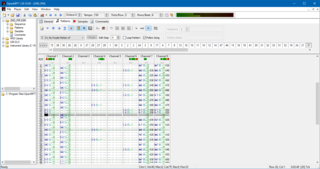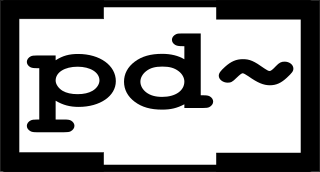
MIDI is a technical standard that describes a communications protocol, digital interface, and electrical connectors that connect a wide variety of electronic musical instruments, computers, and related audio devices for playing, editing, and recording music. The specification originates in the paper Universal Synthesizer Interface published by Dave Smith and Chet Wood of Sequential Circuits at the 1981 Audio Engineering Society conference in New York City. A MIDI recording is not an audio signal, as with a sound recording made with a microphone. It is more like a piano roll, indicating the pitch, start time, stop time and other properties of each individual note, rather than the resulting sound.

A music tracker is a type of music sequencer software for creating music. The music is represented as discrete musical notes positioned in several channels at discrete chronological positions on a vertical timeline. A music tracker's user interface is usually number based. Notes, parameter changes, effects and other commands are entered with the keyboard into a grid of fixed time slots as codes consisting of letters, numbers and hexadecimal digits. Separate patterns have independent timelines; a complete song consists of a master list of repeated patterns.

Modular synthesizers are synthesizers composed of separate modules for different functions. The modules can be connected together by the user to create a patch. The outputs from the modules may include audio signals, analog control voltages, or digital signals for logic or timing conditions. Typical modules are voltage-controlled oscillators, voltage-controlled filters, voltage-controlled amplifiers and envelope generators.

CV/gate is an analog method of controlling synthesizers, drum machines, and similar equipment with external sequencers. The control voltage typically controls pitch and the gate signal controls note on-off.
Open Sound Control (OSC) is a protocol for networking sound synthesizers, computers, and other multimedia devices for purposes such as musical performance or show control. OSC's advantages include interoperability, accuracy, flexibility and enhanced organization and documentation. The first specification was released in March 2002.

Virtual Studio Technology (VST) is an audio plug-in software interface that integrates software synthesizers and effects units into digital audio workstations. VST and similar technologies use digital signal processing to simulate traditional recording studio hardware in software. Thousands of plugins exist, both commercial and freeware, and many audio applications support VST under license from its creator, Steinberg.

A digital audio workstation (DAW) is an electronic device or application software used for recording, editing and producing audio files. DAWs come in a wide variety of configurations from a single software program on a laptop, to an integrated stand-alone unit, all the way to a highly complex configuration of numerous components controlled by a central computer. Regardless of configuration, modern DAWs have a central interface that allows the user to alter and mix multiple recordings and tracks into a final produced piece.

Audio editing software is any software or computer program, which allows editing and generating of audio data. Audio editing software can be implemented completely or partly as a library, as a computer application, as a web application, or as a loadable kernel module. Wave editors are digital audio editors. There are many sources of software available to perform this function. Most can edit music, apply effects and filters, adjust stereo channels, etc.

Pure Data (Pd) is a visual programming language developed by Miller Puckette in the 1990s for creating interactive computer music and multimedia works. While Puckette is the main author of the program, Pd is an open-source project with a large developer base working on new extensions. It is released under BSD-3-Clause. It runs on Linux, MacOS, iOS, Android and Windows. Ports exist for FreeBSD and IRIX.
ReWire is a software protocol, jointly developed by Propellerhead and Steinberg, allowing remote control and data transfer among digital audio editing and related software. Originally appearing in the ReBirth software synthesizer in 1998, the protocol has since evolved into an industry standard.

A MIDI controller is any hardware or software that generates and transmits Musical Instrument Digital Interface (MIDI) data to MIDI-enabled devices, typically to trigger sounds and control parameters of an electronic music performance. They most often use a musical keyboard to send data about the pitch of notes to play, although a MIDI controller may trigger lighting and other effects. A wind controller has a sensor that converts breath pressure to volume information and lip pressure to control pitch. Controllers for percussion and stringed instruments exist, as well as specialized and experimental devices. Some MIDI controllers are used in association with specific digital audio workstation software. The original MIDI specification has been extended to include a greater range of control features.

A sound module is an electronic musical instrument without a human-playable interface such as a piano-style musical keyboard. Sound modules have to be operated using an externally connected device, which is often a MIDI controller, of which the most common type is the musical keyboard. Another common way of controlling a sound module is through a sequencer, which is computer hardware or software designed to record and playback control information for sound-generating hardware. Connections between sound modules, controllers, and sequencers are generally made with MIDI, which is a standardized interface designed for this purpose.

The Continuum Fingerboard or Haken Continuum is a music performance controller and synthesizer developed by Lippold Haken, a professor of Electrical and Computer Engineering at the University of Illinois, and sold by Haken Audio, located in Champaign, Illinois.

The Clavia Nord Modular series is a line of synthesizers produced by Clavia, a Swedish digital synthesizer manufacturer. The Nord Modular series, in common with their sister range the Nord Lead series, are analogue modelling synthesizers, producing sounds which approximate those produced by conventional analogue synths by using DSP chips to digitally model analogue circuitry.

The Korg MS2000 is a virtual analog synthesizer produced by the Japanese electronic musical instrument manufacturer Korg.
AudioMulch is modular audio software for making music and processing sound. The software can synthesize sound and process live and pre-recorded sound in real-time.

LV2 is a set of royalty-free open standards for plug-ins and matching host applications. It includes support for the synthesis and processing of digital audio and CV, events such as MIDI and OSC, and provides a free alternative to audio plug-in standards such as Virtual Studio Technology (VST) and Audio Units (AU).

Record is a music software program developed by Swedish software developers Propellerhead Software. Designed for recording, arrangement and mixing, it emulates a recording studio, with a mixing desk, a rack of virtual instruments and effects and an audio and MIDI sequencer. Record can be used either as a complete virtual recording studio in itself, or together with Propellerhead Software's Reason.

QLab is a cue-based, multimedia playback software package for macOS, intended for use in theatre and live entertainment. It is developed by Figure 53, an American company based in Baltimore, Maryland.

The AudioCubes are a collection of wireless intelligent light emitting objects, capable of detecting each other's location and orientation, and user gestures, and were created by Bert Schiettecatte. They are an electronic musical instrument used by electronic musicians for live performance, sound design, music composition, and creating interactive applications in max/msp, pd and C++.
















